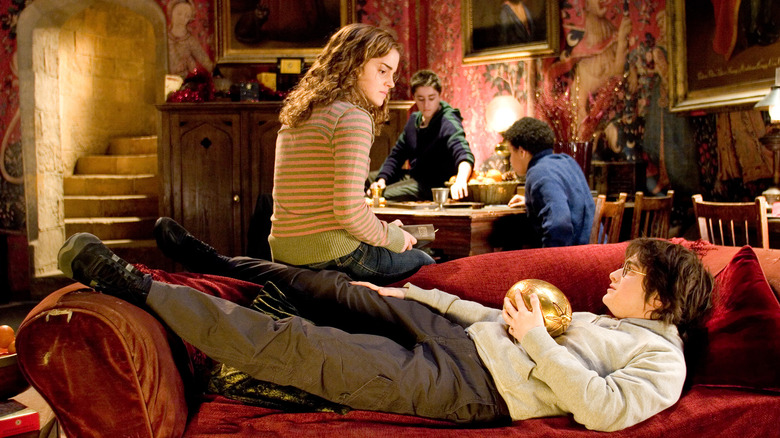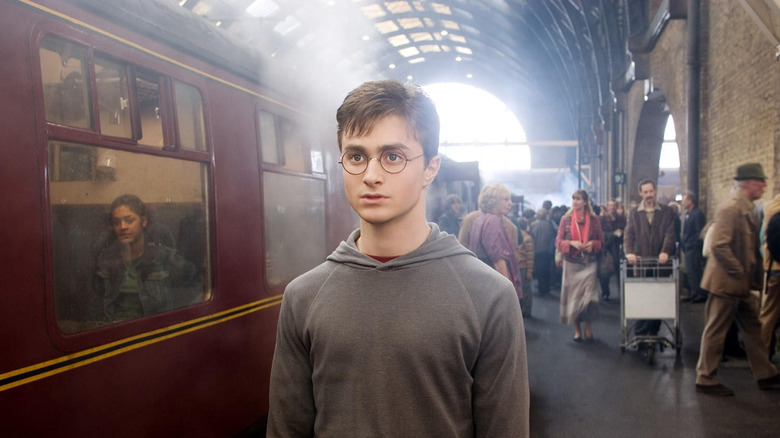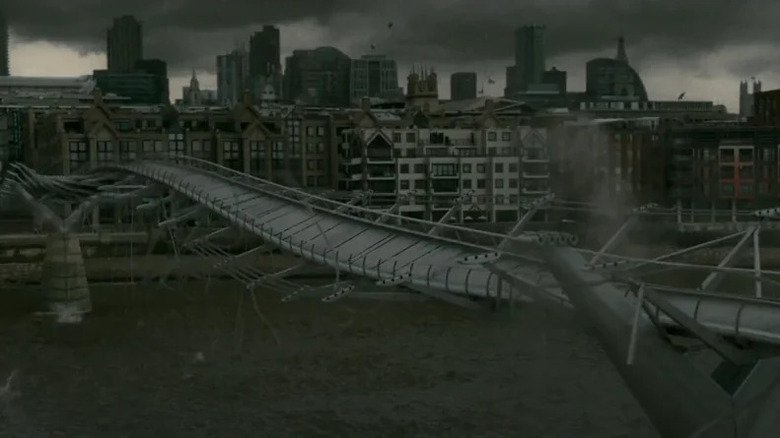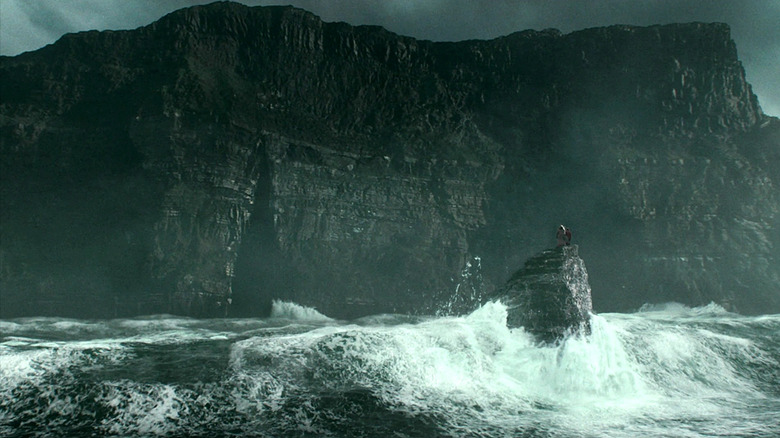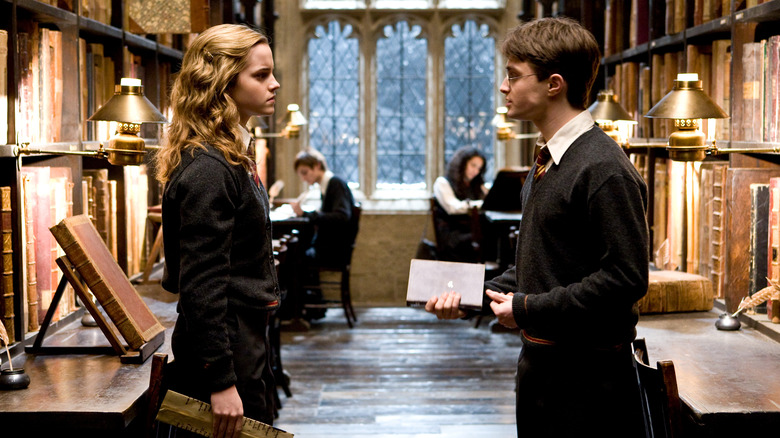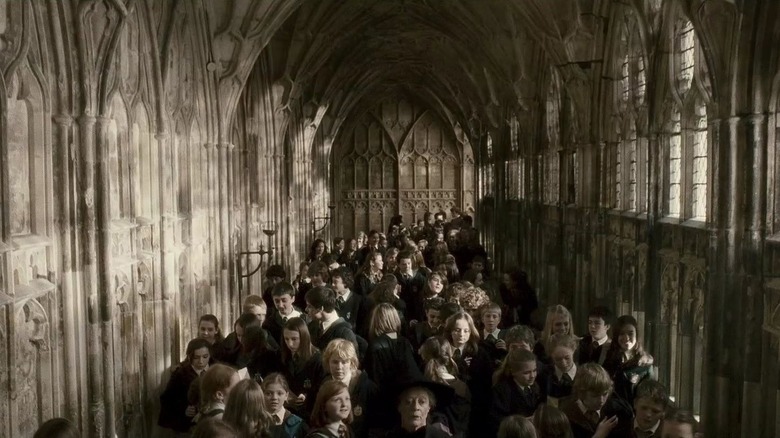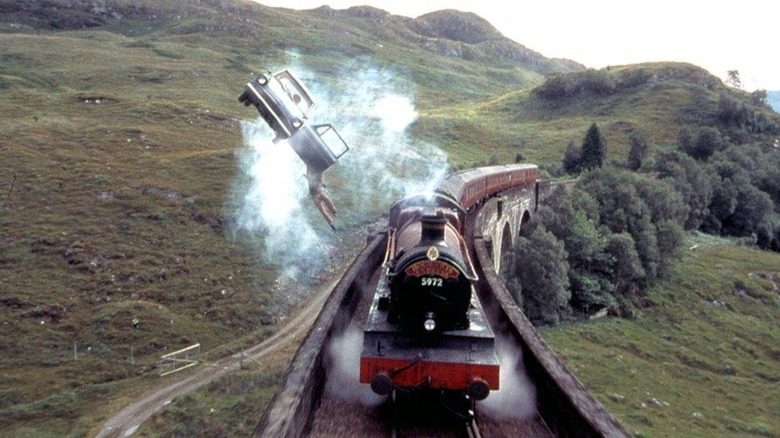Where Was Harry Potter Filmed? Every Major Location Explained
Creating the magical world of "Harry Potter" was a massive undertaking when the film franchise kicked off in 2001 with the very first movie, "Harry Potter and the Sorcerer's Stone" (or, if you don't live in the United States, "Philosopher's Stone"). Warner Bros. and the creative team behind the movies were tasked with bringing Harry's journey at Hogwarts School of Witchcraft and Wizardry to life — and his entire discovery of the magical world in general — and overall, they did a pretty great job! With young actors Daniel Radcliffe, Rupert Grint, and Emma Watson in the lead roles as Harry Potter, Ron Weasley, and Hermione Granger, all of whom were flanked by incredible British actors like the late Alan Rickman and Dame Maggie Smith, and picked up cameras in the United Kingdom to create these magical movies.
So, where did they film specifically? A whole variety of places, frankly — which is normally the case with fantasy movies, who utilize a mixture of sets and natural terrain to create otherworldly stories — but let's break down some of the most important shooting locations in the "Harry Potter" film franchise, some of which you can easily visit if you feel so inclined (and, obviously, find yourself in the U.K.).
Leavesden Studios
A ton of the interior shots for the "Harry Potter" movies, including the interiors of Hogwarts, were built at Leavesden Studios, a massive Warner Bros. lot outside of London. On this set, which spans about 150,000 square feet, the various directors who helmed the "Harry Potter" movies directed actors in sets like the Great Hall, the Gryffindor Common Room, the Forbidden Forest, and non-Hogwarts sets like the interior of the Ministry of Magic, Diagon Alley, and Gringotts Wizard Bank.
This might well be the only entry on this list that is, basically, a temple dedicated to the "Harry Potter" movies, largely because it was created for the franchise and now offers massively popular tours of the space. If you go, you'll be able to gaze upon an (ironically) giant miniature of the Hogwarts castle used for "aerial" shots, walk through many of the sets, and check out features like Harry's increasingly bloodied, disheveled clothes from the final film, "Harry Potter and the Deathly Hallows – Part 2." This collection of sets and props is absolutely enormous, and it makes sense that the studio would open the sets up for tours after the franchise stopped filming in 2011, preserving these carefully crafted pieces of cinematic history for fans to enjoy.
King's Cross Station
When Harry first travels to Hogwarts to start his first year of school, he links up with the Weasley family — meeting his best friend Ron and a few of his siblings — as they all prepare to board the Hogwarts Express before it departs from London. Even casual fans of the franchise know that the track home to the Hogwarts Express is hidden away from non-magical Muggles who use London's busy King's Cross for their everyday commutes; you have to get there by running headfirst at the barrier between platforms 9 and 10 to get to Platform 9 3/4.
Unsurprisingly, King's Cross has taken advantage of this opportunity, and Platform 9 3/4 has, in its way, become real. Thanks to a statue of a luggage cart "jammed" halfway through the imaginary barrier between platforms 9 and 10, you can simply pop by the enormous London train station to see the fictional platform marker and snap a picture of yourself on the trolley (though you should be prepared to wait in a pretty long line to do so, frankly). Obviously, no train departs from Platform 9 3/4, but it's still fun to visit. Also, if you're specifically watching the second movie, "Harry Potter and the Chamber of Secrets," the exterior of St. Pancras International Station is used in place of King's Cross, for some reason.
Millennium Bridge
At the beginning of the book "Harry Potter and the Half-Blood Prince," the unnamed British Prime Minister is visited by the Minister for Magic, who reveals that everything going wrong in the United Kingdom in recent weeks is actually the work of the Dark Lord Voldemort (played by Ralph Fiennes on-screen) and his loyal followers, who call themselves the Death Eaters. The film adaptation of "Half-Blood Prince," helmed by director David Yates, decides to show instead of telling by having Death Eaters destroy London's iconic Millennium Bridge while it's packed with commuters and Londoners, watching as it twists in upon itself and crumbles into the Thames.
This is a cool setpiece — and, obviously, you can walk Millennium Bridge yourself if you find yourself in central London — but there's one problem. The "Harry Potter" story canonically takes place in the 1990s, meaning that "Half-Blood Prince" specifically takes place in 1996. Millennium Bridge's construction started in 1998, the bridge was completed in 2000, and it was repaired after pedestrians reported a disturbing swaying motion, reopening in 2002. It's a cool scene, but it's also a wildly distracting anachronism in the "Harry Potter" movies unless you assume that, like, the movies jump ahead by a full decade for whatever reason (and there's literally no reason to believe that's true).
Cliffs of Moher
When it comes to major "Harry Potter" filming locations, you might not think of the cliffside cave that Harry and his mentor, Hogwarts headmaster Albus Dumbledore (Michael Gambon), discover while they're searching for Voldemort's Horcruxes. It's notable here, though, because it's filmed in Ireland, which is a rare location for the "Harry Potter" films. So what's the deal with the cave? In "Half-Blood Prince," Harry and Dumbledore embark on a mission to learn about Voldemort's past, his Horcruxes — magical objects which contain bits of his soul that can only be created by committing an atrocity like murder — and where they might be hidden, all of which leads them to this awful cave. Within, they find Inferi (dead enchanted bodies) guarding a locket in a basin, and after Dumbledore drinks the entirety of the basin's potion that surrounds the locket, the two wizards narrowly escape with their lives ... only for Harry to realize later that the locket is a fake, and the real one was "disposed" of by a mysterious man named R.A.B.
The filming location for this particular cave is the Cliffs of Moher, a famous natural landmark located in southwestern Ireland. With a few small digital alterations, the team behind "Half-Blood Prince" made the stunning cliffs into a sinister cave, and like many of the other locations here, you can absolutely visit the Cliffs of Moher (which you should do anyway if you find yourself in southwestern Ireland).
Oxford University
It's probably not a big surprise that Oxford University, the oldest university in the English-speaking world located in England, played a part in the "Harry Potter" movies. Perhaps most importantly, the Hogwarts library — which plays a huge role in nearly every single "Potter" film — is Oxford's Bodleian Library, which is located in the storied university's Divinity School. (It's also used as the Hogwarts infirmary in the first movie, pulling double duty.) The cloisters in Oxford's New College play a part in "Harry Potter and the Goblet of Fire" when Harry has a chance meeting with his nemesis Draco Malfoy (Tom Felton) where the Slytherin student gets turned into a ferret by the school's new Defense Against the Dark Arts professor Alastor "Mad-Eye" Moody (Brendan Gleeson). Last but certainly not least, the steps in the university's famous Christ Church College served as the filming location in the first movie when all of the new Hogwarts students climb the steps to the Great Hall to get sorted alongside Dame Maggie Smith's Professor McGonagall.
The bottom line here is that Oxford is a grand, magnificent architectural marvel that serves as an ideal backdrop for, well, a series of films set in a magical castle! Obviously, you can visit and tour Oxford yourself if you want the full "Potter" experience, but also, the university is just worth seeing for its own merits.
Gloucester Cathedral
During the first two "Harry Potter" movies — "Sorcerer's Stone" and "Chamber of Secrets" — Gloucester Cathedral in, well, the English city of Gloucester served as a stand-in for Hogwarts, most notably in the cathedral's massive and beautiful cloisters. As a 2003 article on the BBC notes, the cathedral had to have a little "work" done in order to make it look like a timeless magical castle; electrical outlets were covered with panels, drawings of biblical icons Adam and Eve were temporarily adjusted to look more "appropriate" for the Potterverse, and so on.
It's easy to see why the arched cloister hallways were chosen as a location for the first two "Harry Potter" movies, and next time you're watching either or both of them, keep an eye out for Gloucester Cathedral's cloisters serving as a backdrop for Harry, Ron, and Hermione's many adventures.
Scottish Highlands
Out of all the "Harry Potter" filming locations that weren't built specifically for the movie, various locations in the Scottish highlands get the most play — which isn't surprising since Hogwarts is canonically located in Scotland. Perhaps most recognizable is the Glenfinnan Viaduct, which stands in as the track for the Hogwarts Express every time the students return to the wizarding school and offers sweeping views of the countryside. Steall Falls was also used in "Harry Potter and the Goblet of Fire" during the first task of the Triwizard Tournament, when Harry has to chase an angry Hungarian Horntail dragon and steal one of her eggs (the waterfall is clearly seen during the sequence). The Clachaig Inn, located in Glencoe, apparently served as a filming location for Rubeus Hagrid's (Robbie Coltrane) hut during the third movie, "Harry Potter and the Prisoner of Azkaban."
There are also a few locations important to the "Harry Potter" franchise that aren't featured in the books or films that happen to be located in Scotland if you're a total completionist. For example, series author Joanne Kathleen Rowling finished the final book, "Harry Potter and the Deathly Hallows," at the Balmoral Hotel in Edinburgh, and a lot of the first book was written at the cozy Elephant House Café.
The "Harry Potter" movies are streaming on Max now.

